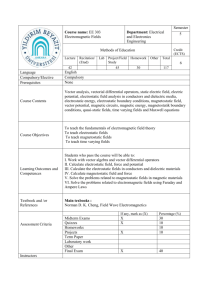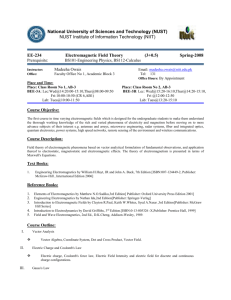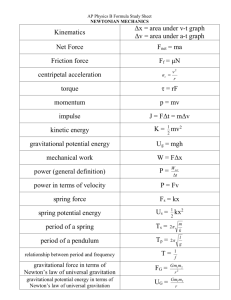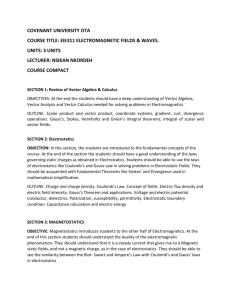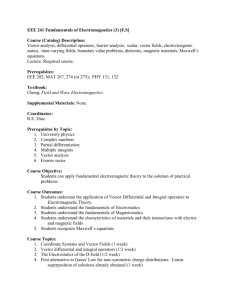Course Material - موقع كلية الهندسة جامعة القصيم
advertisement
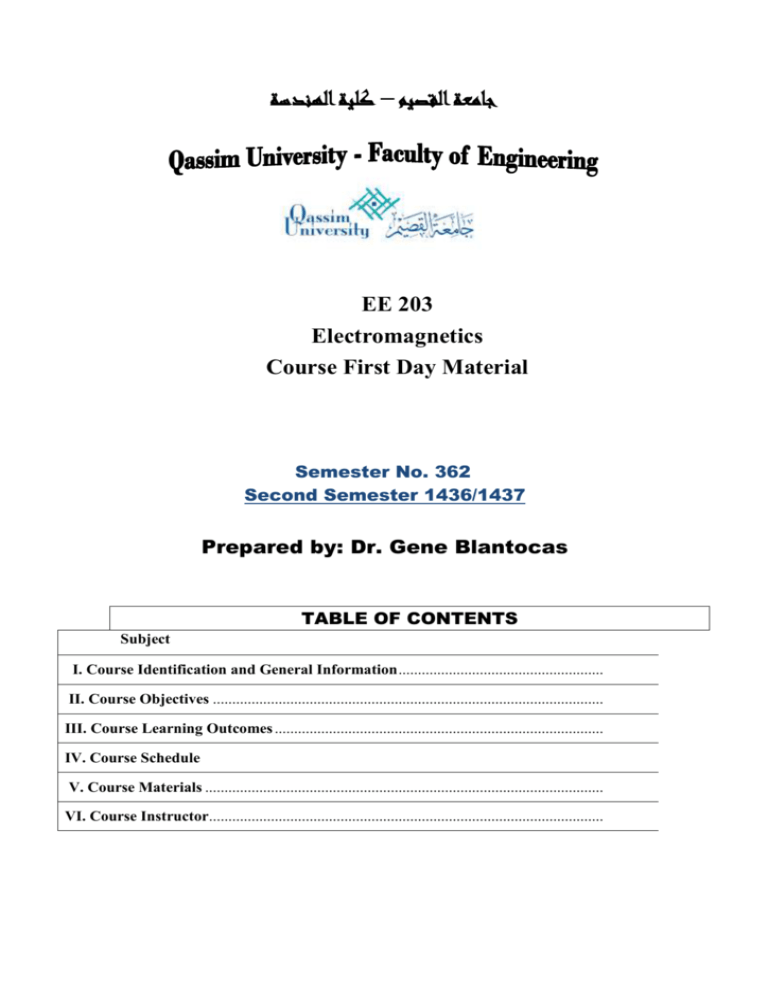
جامعة القصيم – كلية الهندسة EE 203 Electromagnetics Course First Day Material Semester No. 362 Second Semester 1436/1437 Prepared by: Dr. Gene Blantocas TABLE OF CONTENTS Subject I. Course Identification and General Information ..................................................... II. Course Objectives ..................................................................................................... III. Course Learning Outcomes ..................................................................................... IV. Course Schedule V. Course Materials ....................................................................................................... VI. Course Instructor...................................................................................................... EE 203: Course First Day Material Page 2 of 5 I. Course Identification and General Information 1 Title and code Electromagnetics, EE 203 2 Program(s) on which the course is given Electrical Engineering 3 Level of programs: Level 4 4 Prerequisite Physics 104 5 Credit hours (Theoretical, Tutorial, practical) 3 (3, 1, 0) 6 Course Instructor: Dr. Gene Blantocas 7- Catalog Description Review of vector calculus; Electrostatic fields; Gauss's law and divergence; Electric potential; Dielectrics and capacitance; Poisson's and Laplace’s equations; Charge images; Current density and conductors; Magnetostatic fields; Biot–Savart and Ampere's laws; Curl and Stoke's theorem; Magnetic materials and circuits; Self and mutual inductances; Energy in static Fields. Maxwell’s Equations 8- Student Performance Assessment Methods Method of assessment Percentage of total 04 % 1 Attendance 2 Quizzes 10 % 3 Homework, Reports and Seatwork 08 % 4 Two Mid Term Exams 5 Final Exam 2×15 %=30 % 50 % Total (Note: 2% Bonus are given to students who attend more than 95% of classes) 102 % 9- Text Books and References Text Books - References - Elements of Electromagnetics, 5th Edition, Matthew N. O. Sadiku, Oxford University Press, 2011 Engineering Electromagnetics, 8th Edition, William Hayt and John Buck, McGraw-Hill, 2011 Introduction to Electrodynamics, 3rd edition, David J. Griffith, Prentice Hall, 1999 Semester No. 362–Second Semester 1436/1437 EE 203: Course First Day Material Page 3 of 5 II. Course Objectives The objectives are to: a. Provide the students with an understanding of the fundamental concepts of static electric and magnetic fields as applied to the field of electrical engineering b. Enable the students to bridge the gap between electromagnetic theory and engineering applications c. Enable the students to qualitatively analyze and describe electromagnetic aspects of electrical engineering problems d. Enable the students to quantitatively analyze the electromagnetic behavior of simple physical configurations e. Enable the students to further develop mathematical and analytical problem solving skills f. Equip the students with the necessary learning skills (mathematical and technical) for use in other advanced courses such as electric machines and communication courses. III. Course Learning Outcomes Students who successfully complete the course will demonstrate the following outcomes: a. Understand the fundamental concepts of electrostatic and magnetostatic fields and their associated scalar and vector potentials. b. Develop competence in determining the electric fields and scalar potential of charged systems in cartesian, spherical and cylindrical configurations using Coulomb and Gauss’s Laws. c. Develop competence in determining themagnetostatic fields and the magnetic potential of current distributions using Biot-Savart Law, Ampere’s Law, Gauss’s Law, Laplace’s and Poisson’s Equation for magnetostatics. d. Develop competence in solving for the energy and energy densities of electrostatic and magnetostatic distributions. e. Develop competence in solving problems associated with the phenomena of polarization and magnetization. f. Understand boundary conditions at interfaces of dielectrics and magnetic materials. Thus enabling the student to solve for electrostatic and magnetostatic fields from boundary relations. g. Develop competence in solving electrostatic and magnetic boundary value problems described by cartesian, spherical and cylindrical coordinate systems using Laplace’s and Poisson’s Equation. h. Understand the concept of capacitance and inductance. Relate the study of mutual inductance and magnetically coupled circuits to the principles of transformers. i. Understand the concept of magnetomotive force (mmf), reluctance and magnetic flux. Thus enabling the student to construct and analyze magnetic circuits. j. Develop competence in using the Lorentz force law on practical applications such as simple machines and transmission lines. k. Be able to summarize the entire theoretical content of electromagnetic theory through Maxwell’s equations. IV. Course Schedule Semester No. 362–Second Semester 1436/1437 EE 203: Course First Day Material 1st 2nd 3rd 4th 5th 6th 7th 8th 9th 10th 11th Page 4 of 5 Review of vector algebra Coordinate systems and transformation, vector calculus, the Divergence and Stoke’s theorem, the Laplacian Electrostatic fields, coulomb’s law of discrete and continuous charges Electric flux density, gauss’s law, applications of gauss’s law, electric scalar potential Relationship between electrostatic fields and the scalar potential and introduction maxwell’s equations Electric dipole, energy and energy density Electric fields in material space, properties of materials, convection and conduction currents Conductors, dielectrics and their properties, polarization, capacitance and boundary conditions between two media Boundary value problems, applications of Poisson’s and Laplace’s equations in different coordinate systems Magnetostatic fields, Biot-savart and Ampere’s law, magnetic flux density, magnetic scalar and vector potentials Comparison between magnetostatic and electrostatic fields, maxwell’s equations as applied to magnetostatics 12th Applications in electrical engineering, Helmholtz coil, solenoids, toroids, long coaxial transmission lines th 13 Magnetic force, magnetic dipole, magnetic materials, energy in static fields, Magnetic boundary conditions between two media th 14 Magnetic circuits and their applications 15th Maxwell’s equation for time varying fields, Faraday’s law, Lenz law, Displacement current, show how Maxwell’s equations summarizes the field of electromagnetics V. Course Material Most of the documents used in EE 203, lecture notes, assignments and solutions to exams / quizzes are available for download from the following web site: http://qec.edu.sa/eng/students/lectures/lectureres.asp VI. Course Instructor 1 2 Personal Data Name e-mail Dr. Gene Blantocas gene@qec.edu.sa or gqblantocas@gmail.com Academic Degrees Degree Major PhD Physics (Specialization: Plasma Physics) MSc MA Physics Physics Institute University of the Philippines in collaboration with Doshisha University, Japan University of the Philippines University of the Philippines Semester No. 362–Second Semester 1436/1437 Date 2004 2001 1996 EE 203: Course First Day Material BSc Electrical Engineering (Specialization: Power Systems Engineering) Page 5 of 5 Western Institute of Technology, Phil. Semester No. 362–Second Semester 1436/1437 1990
